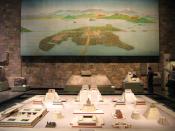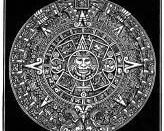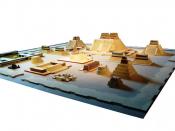An example of monumental archetecture within the Aztec society is the great pyramid of
Tenochtitlan. It was created by the revered speaker Montecuzoma I, who was the ruler of
the Aztecs in 1466. The pyramid was not finished until the rule of Montecuzoma II,
around 1508. (Carrasco, Moctezumas Mexico, Pg 49.)
The pyramid was known to the Aztecs as the 'icpac tlamanacali,' or The Great Pyramid.
It's base was square, and 150 yards to a side. It rose toa height of 70 yards, and had
smooth sides. The staircase ascending the front was actually two staircases, one for people
going up and one for people going down. The staircases were separated by an ornamental
gutter for blood to flow down. The pyramid was used as an sacrificial altar on which
people were sacrificed to the gods, known to the Aztecs as the 'Flowery Death.'
(Jenning's, Aztec, Pg 92.)
The temporal and spiritual heart of the Aztec empire was the island capital of
Tenochtitlan, and more specifically, it's ceremonial precinct and the Great Pyramid.
Crisscrossed by canals paralleled by streets, it was described by the conquistadors as
'another Venice.' Like that country, the ready access to water transport made heavy
commerce a reality. It is said that 200,000 canoes could be found on the lake in the early
16th century. (Coe, Atlas of Ancient America, pg 125.)
It is difficult to estimate the size of the city when Cortes first arrived but it is estimated at
100,000 with the Aztec empire containing more then 10 million. (Coe, Atlas of Ancient
America, pg 128.)
Unlike European provinces, Aztec cities and towns had working drinking water and
waste treatment systems. An intricate plumbing system using clay pipes ran down from the
mountains around Mexico valley to all of the towns and cities in...


